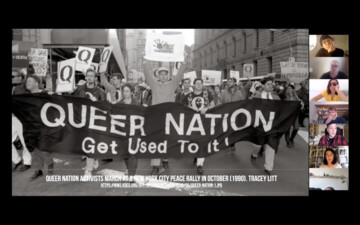“Queering” is the gerund form of the word “queer”, and comes from an abbreviation of the phrase “queer reading”.[1] It is used as a method that questions heteronormativity and gender binarism, and can be applied to literature, film, or art in order to challenge preconceived ideas about gender and sexuality. While in the beginning the queer method dealt more strictly with gender and sexuality, it quickly expanded, becoming a general term that addresses a great variety of systems of oppression and identity politics, such as gender, ethnicity, class, sexual orientation, age, nationality, or disability, among others. In the context of queer theory, queer is something that we do, rather than something that we are (or are not).
The term ”queer”, historically, has meant weird, strange, or outside the norm. This insult, which was reappropriated and re-signified in the 1990s by gender- and sexuality-dissident collectives, also started to be used as a verb in gerund form in an attempt to transmit radicality, questioning, and transformation. As a verb form of “queer”, “queering” can refer to the act of taking something and looking at it through lenses that make it appear strange, that displace, disrupt, or disorient it in some way. The act of reading, visualising, or analysing something from a queer perspective is a practice that we tend to call “queerifying”, given that it usually involves making a text, an audiovisual, or even a museum collection somewhat queerer by analysing it from this perspective. There is no true, absolute reading of any cultural production, but rather there are always multiple possible readings, and those who read or observe these productions involve themselves in the meanings that are produced.
Around the decade of the 1940s, in the Anglo-Saxon context, the word queer began to be used to refer to those whose sexuality deviated from the heterosexual norm. The term changed at the end of the 1980s and beginning of the 1990s, when various groups of LGBTI activists, such as Act Up, Queer Nation, or Lesbian Avengers, led the fight against AIDS. They transformed the meaning of this term, → reclaiming it as a positive indicator and a process of questioning the dominant ideas about what was (and is) considered normal. They also expanded the use of the term as a way of overcoming the assimilationist tendencies that existed within the very activist movement against AIDS, granting the word a new meaning with a more radical character. “Queering”, then, becomes a tool for the social and political subversion of the dominant culture.
As a result of the interactions produced between queer theory and pop culture, this method of analysis has pierced and pierces multiple and diverse cultural phenomena, such as art, literature, mass media, film, fashion, and even music. It is perhaps surprising to discover that the concept of queering played a role in the popular music of the disco culture. In fact, there exists a clear relation between the Stonewall Uprising in New York and the birth of disco. Within the club scene of this era, heterosexual norms dominated the dance floor. As a consequence of queering as a musical phenomenon, the people who went to these events danced by themselves, or same-sex dance partners took to the floor[2]. Nowadays, we can enjoy some of these musical proposals by investigating the work of the author of the well-known text “I Am Not a Lesbian!”[3], Terre Thaemlitz, who produced the album Queerifications & Ruins (2013) in Japan with sounds that Thaemlitz herself has defined as queer underground deep house.[4]
Surfing the web, we can also discover the project Queering the Map, a counter-mapping platform generated by the community to digitally archive the LGBTQ2IA+ experience in relation to physical space. The platform provides an interface that allows us to cartographically register the queer experience and visualise it at an international level, an authentic living archive of queer life that reveals the ways in which we are intimately connected.[5] Another interesting queer cartographic intervention project is called Metro LGTBI de Madrid [“Madrid LGBTI Metro”] (2016), created by activist Javier Sáez, who, upon observing the metro map of the city, realised that it contained no reference to the LGBTQI community; he therefore decided to reimagine the Madrid metro using gay, lesbian, transgender, and queer elements.[6]
Archives and museums as institutions have not been exempt from these queer interventions. A particularly fruitful example is that of the Van Abbemuseum in Eindhoven, the Netherlands. An internal working group known as Queering the Van Abbe has emerged, which has undertaken projects such as Queering the Collection, which intends to transform the museum itself into a more inclusive space, and Queer Glossary[7] (2015), which aims to propose a terminology related to queer matters from a personal perspective, among many other proposals. For this collective, queerifying the museum means flowing in terms of identity, sexuality, and politics. “The Van Abbemuseum is moving in a queer direction. Connect here to bring to life a queer element within the museum.”[8]
In my own trajectory as an artist, this methodology appears quite clearly in my project Gendernaut,[9] a research project and artistic practice that, in a first phase titled Queering the Software, questions the ways in which the hegemonic archive is constructed through the design of a plugin that allows for the collective creation of archives through an online interactive multimedia experience. In a second phase, titled Queering the Archive, it proposes new ways of visualising narratives based on queer and → transfeminist genealogies through transmedia and performative experiences that conceive of the archive as an interactive live space, free from heteropatriarchal codes, a space inhabited by multiple bodies and subjectivities that put in relation the past, present, and future to come.


![Subjectivisation 2 [Discussion #2]](/website/var/tmp/image-thumbnails/0/1476/thumb__logo/Discussion-2.png)
![Subjectivisation 2 [Final discussion]](/website/var/tmp/image-thumbnails/0/1478/thumb__logo/Mick-final-discussion.png)
